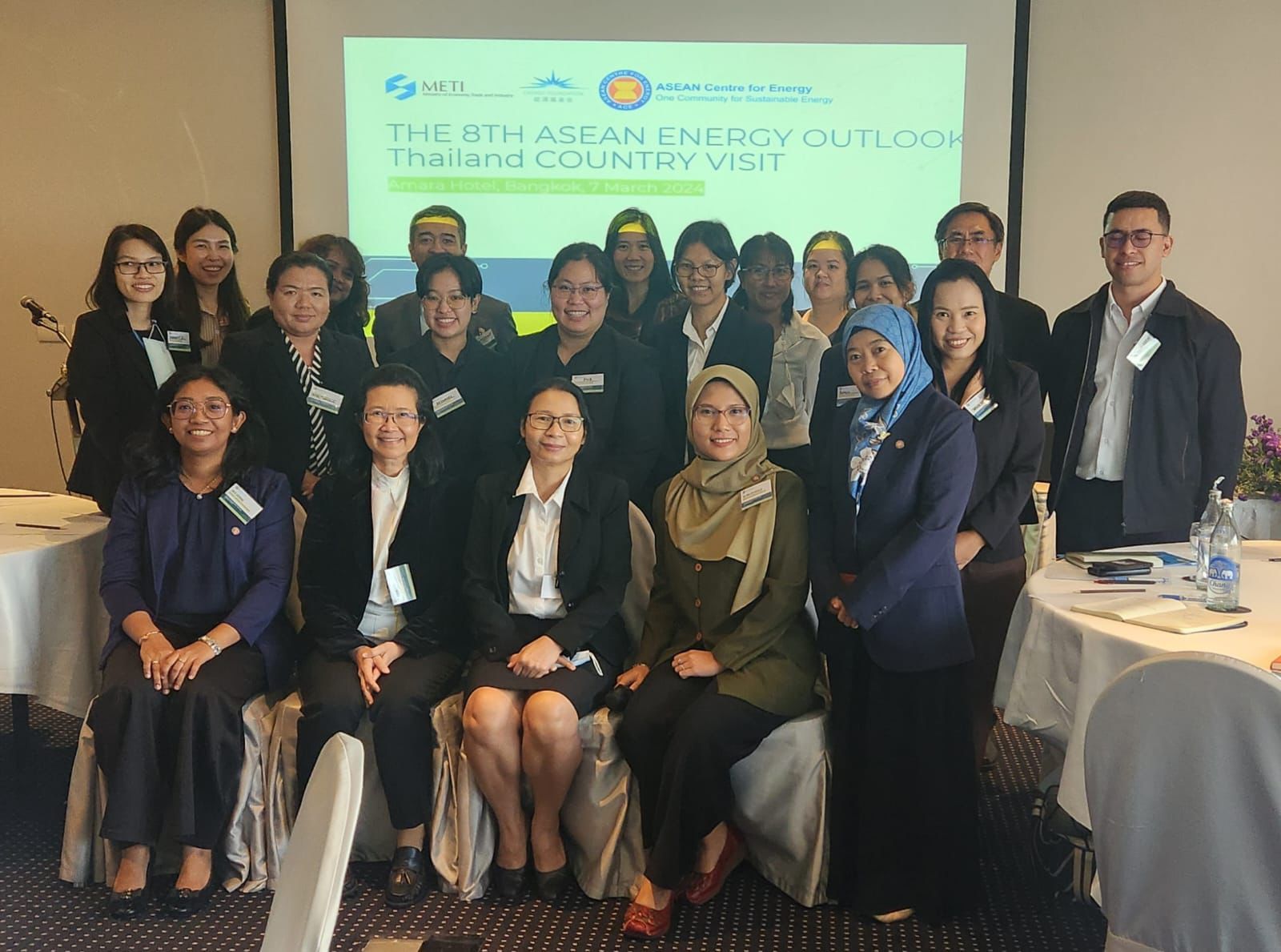Menu

Photo 1. AEO8 Team with Thailand Officials During Country Visit to Thailand
During the period of January and March 2024, the ASEAN Centre for Energy (ACE) visited ten ASEAN Member States (AMS). The country visit serves to follow up after the first 8th ASEAN Energy Outlook (AEO8) Workshop, discussing initial findings and addressing any additional matters. On 7 March 2024, ACE conducted the AEO8 Country Visit to Thailand, following the visits to Myanmar, Indonesia, Brunei Darussalam, Malaysia, and the Philippines. During these visits, ACE invites energy officials and relevant stakeholders from AMS to gain additional input and check for the modelling, such as detailed data, assumptions, and initial findings.
The country visit started with a progress report on AEO8, presented by Rika Safrina, Senior Analyst of ACE’s Energy Modelling and Policy Planning (MPP). This aims to show the current progress of AEO8 and the improvements implemented by AEO7. The participants raised many questions and feedback, including energy access, carbon tax, land use for renewables, job employment, air quality, and energy investment.
The country visit also serves to receive input and discussion on the next APAEC cycle 2026-2045 Phase I: 2026-2030, led by Rika Safrina. These discussions seek input on various topics, including regional objectives, targets, plans, technologies, and expectations of regional programs. As the current APAEC cycle is due to end in 2025, these discussions will help create a regional roadmap that AMS can use to aid in their individual energy planning. From the surveys filled out by the participants during this event, the top priorities for the energy sector in Thailand are energy affordability and accessibility. Some participants also highlighted the impact of energy trade-offs, such as biomass vs food crops and electric vehicle vs conventional fuel, to be considered in the APAEC Post-2025.
Ending the morning half of the country visit was a demonstration of LEAP, the software used for data modelling in AEO8, also given by Rika Safrina. This session is meant to show Thailand’s representatives how the data is used and the results achieved for AEO8. The demonstration showcased LEAP’s features and ability to interpolate any missing data, among others.

Photo 2. Participants of AEO8 Country Visit to Thailand
The afternoon part of the event consisted of discussions on data and findings. First, the data discussion was led by Silvira Ayu Rosalia, Energy Statistician and Data Visualisation Officer of ACE. The session focused on the available energy-related data and policies of Thailand that ACE currently has and to follow up on any new ones. The meeting noted two important energy policies of Thailand, namely the Alternative Energy Development Plan (AEDP) 2018-2037 and the Energy Efficiency Plan (EEP) 2018-2037, among others. Timely and updated data will produce more accurate results in Thailand’s energy model, contributing to the regional model.
The next presentation was about the initial findings of the Baseline Scenario and AMS Target Scenarios (ATS), given by Dr. Ambiyah Abdullah, MPP Senior Officer of ACE. The presentation focused on the two basic scenarios of AEO8, including the associated assumptions and projections. ACE would like to confirm whether the results and forecasts for these two scenarios reflect the real conditions in Thailand’s energy sector. Any concerns and inputs will be addressed before the final results are achieved, expected in June 2024. The differences in carbon emissions and investment costs between the two scenarios were also shown to Thailand stakeholders for their feedback.
Immediately after, there was a discussion about other scenarios, also moderated by Dr. Ambiyah Abdullah. This session focused on the remaining two scenarios: the Regional Approach Scenario (RAS) and the Carbon Neutrality Scenario (CNS). This resulted in the assumptions and potential technologies that could be included to model these two scenarios for Thailand’s case.
The last presentation was about energy financing, led by Dr. Ambiyah Abdullah. Energy financing, particularly in clean energy, is still a significant issue in ASEAN, and this session aims to showcase the current status of energy investment and best policies and practices from other AMS. This part of the meeting also discussed the challenges faced by energy financing and the implications of supply disruptions from geopolitical conflicts. Specifically for Thailand’s situation, the participants pointed out that private sectors need directions and good signals from the government regarding internal regulations based on the country’s energy roadmap to move forward with constructing new power plants.
Ending the country visit was a closing remark provided by Rika Safrina. She highlighted the good progress this consultation visit had produced, especially in improving the data modelling and information availability for AEO8.
—
AEO8 development is supported by several partners, including the Ministry of Economy, Trade and Industry (METI) Japan, the Norwegian Government through the ASEAN Climate Change and Energy Project (ACCEPT) Phase II, the USAID through Smart Power Programme (SPP), Australian Government through Partnerships for Infrastructure (P4I), Energy Foundation China, and many technical partners.
